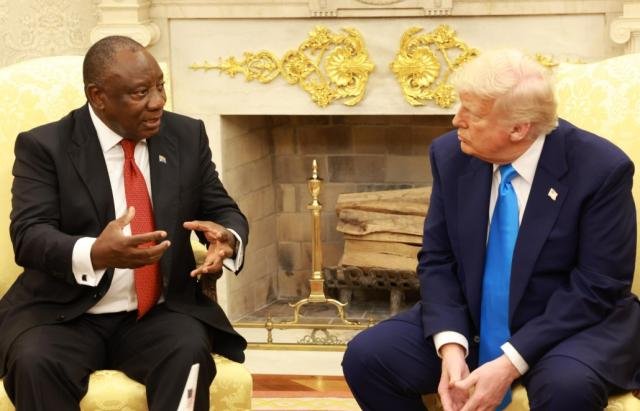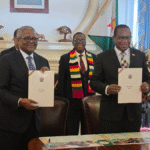A routine diplomatic meeting turned confrontational when former U.S. President Donald Trump confronted South African President Cyril Ramaphosa with unfounded claims of “white genocide” during their Oval Office discussion. The tense exchange, which overshadowed efforts to improve U.S.-South Africa relations, revealed stark differences in how both leaders view racial issues in post-apartheid South Africa.
The meeting began pleasantly enough, with Trump joking about golf with South African sports stars Ernie Els and Retief Goosen. But the mood shifted abruptly when Ramaphosa rejected Trump’s long-standing assertion that white South Africans face systematic persecution. In a move that stunned attendees, Trump ordered staff to dim the lights and play a controversial video supporting his claims.
The footage showed former South African President Jacob Zuma and opposition leader Julius Malema singing “Kill the Boer,” an apartheid-era protest song, along with unverified images of graves marked with white crosses that Trump claimed belonged to murdered white farmers. Through it all, Ramaphosa maintained his composure, calmly explaining these images didn’t reflect government policy while acknowledging South Africa’s broader struggles with violent crime.
Trump doubled down on the debunked “white genocide” narrative, a conspiracy theory popular among far-right groups. He insisted white farmers were being targeted, claiming, “They’re being executed and they happen to be white.” These allegations ignore South Africa’s complex reality: while the country suffers from high violent crime rates, statistics show most victims are Black. White South Africans, who make up just 7% of the population, still control about half the nation’s land and remain economically privileged overall.
The South African leader handled the confrontation with remarkable diplomacy. Drawing on his experience as a key negotiator during South Africa’s transition from apartheid, Ramaphosa emphasized constitutional protections for all citizens while avoiding direct confrontation. His measured responses highlighted the challenges of addressing complex racial and economic issues in a polarized global climate.
This clash occurred amid deteriorating U.S.-South Africa relations. The Trump administration had already taken several punitive actions, including cutting aid, imposing steep tariffs, and expelling a South African diplomat. These tensions deepened with South Africa’s genocide case against Israel at the International Court of Justice, which drew sharp U.S. criticism.
Notably, Elon Musk – who has amplified similar claims about South Africa – attended the meeting. His potential business interests in the country, including Starlink’s licensing challenges due to Black empowerment policies, added another layer to the discussion about race and economics in modern South Africa.
Following the meeting, Ramaphosa downplayed the confrontation while standing firm on facts. He told reporters Trump seemed unconvinced by his own genocide claims, suggesting the former president might have been performing for political audiences. This diplomatic balancing act – maintaining relations while rejecting false narratives – encapsulates South Africa’s challenge in navigating global politics.
The incident raises important questions about how racial issues in developing nations get framed in Western political discourse. As South Africa continues addressing its apartheid legacy through land reform and economic transformation, this Oval Office exchange demonstrates how easily complex national issues can become distorted in international arenas. For policymakers and observers alike, it serves as a case study in how misinformation can derail important diplomatic discussions about race, justice and economic equality.









